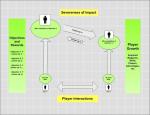The diagram below present a model of the communication process in video games.
In the upper half of the diagram we see the basic relation between video game medium, game discourse and player (the yellow rectangle).
Central to the process is the relation between the open text (the game) and the implied reader (player). The video game medium frames this relationship.
I define interaction as the mutual influencing between the open work and the implied reader over a medium.
The model takes as its basis a distinction between the real player and his configured presence as the implied reader. Rarely ever do games need us as exactly the real persons that we are. In order to take on the role of an actant in the fictional universe of the game we must adhere to certain restrictions on how to use our body (for example in soccer, outfield players must pretend that they have no hands), or we must allow our actions to be translated into the game world through the use of tools (a physical move being represented by playing a card), and must accept certain assumptions and hypotheses on who we are and what we aim to achieve. These are far away from who we are and what we can do as real persons. Without the reconfiguration of the real player as an implied reader who “speaks” in terms of the game vocabulary, the real player would not be able to join the reciprocity cycle.
Narrative, Artefact and Author
The orange and purple shapes at the lower part of the diagram show the relation between narrative (style and content), artefact (software) and author (game developers).
The narrative form of a video game is managed by the game engine whereas the narrative content of a video game is stored as data. Data contains information on game events and existents. The game engine deals with how this information is assembled, articulated and presented via the medium.
Similar to the distinction between real player and implied reader, the model makes a distinction between real author (the game developers) and the implied author (the persona that presents the account). The distinction is meaningful, because the same real author may create narratives whose implied authors are different.
The implied author is an invented unique voice that gives the narrative a consistent approach in the way in which it frames events and actants. The way in which this implied author gives a picture of the game world, may be completely different from the ethical and cultural views of the real author. For example the real author may construct an implied author who is pro-racist in order to make an anti-racist point.
It is mainly the game engine that is designed in a way to construct the game world based on the assumptions of this implied author. However the style and quantity of the data is equally important. An implied reader may for example not say discriminative things about women, yet female characters may be completely absent from the game universe which in certain instances could be interpreted as a sexist stance. The real author will often be held responsible for creating such implied authors.
Filed under: game studies, PhD | Tagged: mediation, narrative, play, video game medium | Leave a comment »




